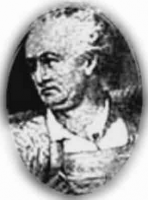










Joseph Aspdin was an English cement manufacturer who obtained the patent for Portland cement on 21 October 1824.
Joseph Aspdin (or Aspden) was the eldest of the six children of Thomas Aspdin, a bricklayer living in the Hunslet district of Leeds, Yorkshire. He was baptised on Christmas Day, 1778. He entered his father's trade, and married Mary Fotherby at Leeds Parish Church (the Parish Church of St Peter at Leeds) on 21 May 1811.
By 1817 he had set up in business on his own in central Leeds. He must have experimented with cement manufacture during the next few years, because on 21 October 1824 he was granted the British Patent BP 5022 entitled An Improvement in the Mode of Producing an Artificial Stone, in which he coined the term "Portland cement" by analogy with the Portland stone, an oolitic limestone that is quarried on the channel coast of England, on the Isle of Portland in Dorset. See below for the text of the patent.
Almost immediately after this, in 1825, in partnership with a Leeds neighbour, William Beverley, he set up a production plant for this product in Kirkgate, Wakefield. Beverley stayed in Leeds, but Aspdin and his family moved to Wakefield (about nine miles away) at this point. He obtained a second patent, for a method of making lime, in 1825. The Kirkgate plant was closed in 1838 after compulsory purchase of the land by the Manchester and Leeds Railway Company, and the site was cleared. He moved his equipment to a second site nearby in Kirkgate.
At this time his eldest son James was working as an accountant in Leeds, and his younger son, William, was running the plant. However, in 1841, Joseph went into partnership with James, and posted a notice that William had left, and that the company would not be responsible for his debts. It can be assumed that William developed his modifications leading to "modern" Portland cement around the time of his departure. In 1844 Joseph retired, transferring his share of the business to James. James moved to a third site at Ings Road in 1848, and this plant continued in operation until 1900. Joseph Aspdin died on 20 March 1855, at home in Wakefield.
Implications of the patent
Aspdin called the product Portland cement because set mortar made from it resembled “the best Portland stone". Portland stone was the most prestigious building stone in use in England at the time. The patent clearly does not describe the product recognised as Portland cement today. The product was aimed at the market for stuccos and architectural pre-cast mouldings, for which a fast-setting, low-strength cement was required (see cement). It was fired at low temperature (below 1250 °C) and therefore contained no alite.
The product belongs to the category of "artificial cements" that were developed to compete with Parker's Roman cement, and was similar to that developed much earlier by James Frost. The process described is a "double burning" process in which the limestone is burned on its own first, then slaked, mixed with clay, and burned again. This was a common practice for manufacturers of both Artificial and Portland cements when only hard limestones were available. The grinding technology of the time consisted only of flat millstones, and it was more economic to comminute the limestone by burning and slaking than by grinding.
The limestone he used was the Pennine Carboniferous limestone of the area, which was used for paving in the towns and on the turnpike roads. The characteristic practise of the patent (and of his lime patent) is the use of "road sweepings" as a raw material. He says that if the sweepings are not available he obtains 'the limestone itself". It is significant that Aspdin was twice prosecuted for digging up whole paving blocks from the local roads. Limestone supply was clearly a major headache for Aspdin in the days before stone could be brought in by rail. This provides context for the friction that developed with his son William. William's innovation was to make a mix with a higher limestone content, to burn it at a higher temperature using more fuel, and to grind the hitherto-discarded hard clinkered material, hence increasing wear-and-tear in the grinding process. William subsequently moved south to north-east Kent, where inexhaustible supplies of soft chalk were available, and launched the "modern" Portland cement industry.